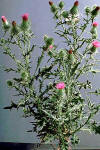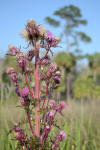WILD
FOODIES' HOME PAGE
PLANT PROFILE LIST
NAME: Bull Thistle
SPECIES / FAMILY: Cirsium Horridulum / Asteraceae
OTHER COMMON NAME(S):
CONDITIONS: sun, sandy
|
PARTS: |
EDIBLE |
TASTE |
RAW/COOK |
SEASON |
|
All |
|
|
|
|
|
Shoots |
|
|
|
|
|
Leaves |
|
RAW/COOK |
Spring |
|
|
Stalk/Stem |
|
|
RAW/COOK |
Spring |
|
Buds |
|
COOK |
Spring/Summer |
|
|
Flowers |
|
|
|
|
|
Fruits |
|
|
|
|
|
Pods |
|
|||
|
Seeds |
|
|
COOK |
Summer |
|
Nuts |
|
|
|
|
|
Roots |
|
|
|
Fall |
|
Bark |
|
|
|
|
PORTION: small
COMMENT: “The first-year root and leaves are edible… Raw, boil or steamed hollow inner stalks peeled of green outer fiber; core of unopened flower buds, when cooked squeezed out like artichoke leaves; stripped midribs raw or cooked. First year roots once large enough to harvest, The seeds are edible, 12 pounds will produce 3 pounds of edible oil. Suitable for cooking or lamp use.” (2)
CAUTION: Use gloves to avoid spikes. Soak roots for 24 hours & change water once before cooking in order to avoid flatulence. // “…wear heavy gloves when working with thistles, and some people have contact dermatitis with thistles.”(2)
NUTRITION/MEDICINAL: “Native American Indians used thistle for neuralgia, over eating, an herbal steam for rheumatism and to shrink hemorrhoids (presumably without the thistles!)”(2) “A tea can also be made from the leaves and the plant was used in ancient times to treat varicose veins, which in Greek is kirsos.”
LOOK-A-LIKES: Cirsium vulgare https://www.pfaf.org/user/Plant.aspx?LatinName=Cirsium+vulgare
POISONOUS LOOK-A-LIKES:
OTHER USES: Seed oil suitable for lamp use… The plant also grows fibrous as it ages — why we don’t eat older stalks — and can be used for cordage. Soaking the plant several days in water makes the threads available. Also, the seed fluff when dry is great tinder. And should you be in the wilderness with little but a thistle for protection, know the Seminole Indians made blowgun darts from the plant. That might require a remaking of the common phrase: I’ve got a thistle stuck in the thick of my tongue. The down was used as guide feathers for arrows. “ (2) “The thistle, by the way, is also food for the larva of the American Painted Lady butterfly, Black Swallowtail, Delaware skipper, Palamedes Swallowtail, Palmetto Skipper), Three-Spotted Skipper, Twin-Spot skipper (What? No One-spotted skipper?) and other butterflies. Goldfinches like the seeds, too.”(2)
SOURCE LINKS (may include nutritional and medicinal info, plus other uses):
- https://pfaf.org/user/plant.aspx?LatinName=Cirsium+vulgare (related)
- http://www.eattheweeds.com/thistle-touch-me-not-but-add-butter-2
- https://en.wikipedia.org/wiki/Cirsium_horridulum
- http://www.foragingtexas.com/2008/08/thistle.html (good photos)
- http://www.ediblewildfood.com/bull-thistle.aspx (good photos)


_(6031255316)_small.jpg)
_small.jpg)